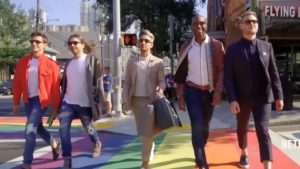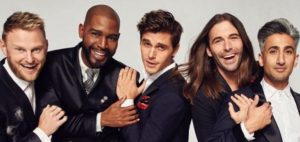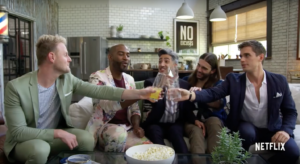Since I’ve been more “out” about my involvement in media studies the last couple of years, at any given time I get a lot of people asking me “What are you watching?” For the longest I’ve been recommending Wynonna Earp and the like. It’s still a very fun show, and I continue to advocate for it, but we’ve gotten a new crop of LGBTQ rep featured on network shows like Black Lightning (Stop sleeping on this one, y’all!) and streaming fare such as One Day at a Time and Everything Sucks. I’ll hopefully get to those on this blog as well, but right now I want to put in a plug for the new Queer Eye.
I initially started streaming this Netflix series not because I enjoyed the early 2000s original (I didn’t, especially) but because it features Jonathan Van Ness of Gay of Thrones fame. If you have any interest in Game of Thrones at all, you owe it to yourself to view Jonathan’s rundowns on the episodes. Honestly, I only watched the most recent season of GoT just so I could coherently enjoy Jonathan’s hilariously gay recaps, which he delivers while he does the hair of random semi-famous people and/or members of the GoT cast. Just trust me on this one.
People criticized the original Queer Eye for the Straight Guy series because it relied largely on stereotypes about gay guys being experts on fashion, entertaining, etc. The makeover format was big in early 2Ks reality TV, and QEftSG was a cable hit. But a lot of us in the community, myself included, felt that the queer visibility wasn’t worth the reinforcement of stereotypes. Going on memory – because I did watch the original QE on occasion – I don’t recall the cast engaging emotionally with their makeover subjects. I do remember feeling like they attempted to put a real damper on their overt gayness (despite the reliance on stereotypes) for the comfort of straight audiences, the exception who proved the rule being Carson. He served as the show’s gay id in all his flamboyance. They talked little of their personal lives or romantic/sexual interest in men, and I don’t recall them being flirty with their subjects.
Perhaps it’s the difference in the platform (streaming vs. basic cable), or just the times have changed in 15 years, but the new QE feels fresher, gay-er, but simultaneously less about gayness and more about shared humanity than I recall from the previous iteration. Specifically, the new crew shares what I’m going to call a utopian (as opposed to toxic) masculinity with their makeover subjects. I think this stems in part from the fact that they don’t particularly strive to make the audience comfortable with their gayness. They assume that the audience already is comfortable or will adapt quickly, much like the guys they make over.
What they don’t assume is straightness. Notice the title is simply Queer Eye this time around, having nixed “for the straight guy.” A young gay man named AJ is the subject of episode 4, and they help make him over in a bid to bring him the confidence to come out to his stepmother. The emotional aspect of this experience figures heavily in the show, and the audience gets considerable backstory of AJ’s family history. The episode particularly highlights the not-incidental fact of AJ’s intercultural African American/Mexican blended family and how that has played into his previously reserved expression of his sexuality.
The treatment of AJ is not unique because he happens to be a gay man. The episodes all follow a similar pattern in which we come to understand why the guy in question has “let himself go.” We often learn that the subject doesn’t express himself as fully as he might due to lack of confidence, overinvestment in career goals, or some kind of emotional setback such as a divorce, loss of a family member, and the like. We get single men, family men, working- or middle-class guys who have let self-care fall by the wayside. The new QE crew approaches each case in a wholistic way, not just as a tragic fashion casualty with hilariously terrible taste. Overall, there’s a distinct lack of bitchiness, despite all the “yass queen!” sass that one would expect from a show like this.
Yet even with Jonathan’s overt, unapologetic queeniness and Tan’s perfectly coiffed hair and eyebrows, the cast always approaches their featured guests as men first and foremost. They connect with the guys on topics such as working out, their work lives, family, even religion. Bobby has a touching discussion with the religious family man “Straight Bobby” in episode 5, speaking candidly of his religious upbringing and the rejection he felt from the church as a gay teen. The two have a heartfelt moment of connection, culminating when Straight Bobby tells the guys that they are always welcome in his home and that he genuinely loves them. As a southerner raised as a staunch Southern Baptist, and having felt a good bit of the rejection QE Bobby described in this episode, I shed real tears.
In episode 3, Karamo has a serious discussion with white cop Cory about the policing of Black communities and the Black Lives Matter movement. It honestly feels groundbreaking to see Cory come to a new understanding of the subject. He is the epitome of the Republican White Guy with his love of NASCAR and actual Tr*mp election signage that the guys find in his basement.
Most remarkable to me about this new iteration of QE is the empathetic approach the guys take to the obvious emotional hurts their guests have suffered and to the vulnerability these guys show in
the Crew’s presence.
Episode 1 features semi-retired Tom, who remarks several times about how “ugly” he feels, and it’s sadly obvious that’s what other men in his life have told him. Jonathan has a heart-to-heart with him about the fact that there are many things he can do to make himself more confident, and confidence is sexy. The other guys echo this sentiment throughout this episode.
I got the sense in this conversation, and in several other similar moments in this and other episodes, that these typical southern straight men have probably never had other men give them any kind of confidence-boosting affirmation. An insidious aspect of toxic masculinity seems to entail men tearing each other down in a bid to not seem effeminate.
All of the guys in the episodes appeared touched by the matter-of-fact appraisals of the Crew that they are “handsome” or “sexy.” More importantly, these guys feel comfortable enough in one-on-one conversations to reveal their vulnerabilities and accept emotional support, even supportive touching and hugs, in a way that they might not have ever done with straight peers. This was maybe the first time I’ve noticed something I’d call utopian or nontoxic masculinity at work.
As a woman, I’ve always enjoyed emotionally supportive relationships with my women friends, gay and straight alike. Hugs, supportive physical touch, and understanding in the face of emotional vulnerability are very much a part of my connections with the women in my life. It had never occurred to me that many men do not feel allowed to share these kinds of positive moments with other men due to the strictures of toxic masculinity. That is honestly sad, not just for the men themselves, but for what it does to society.
Seeing these straight guys accept and appreciate platonic affection and support from gay men, even good-natured innocent flirting at times, made me feel something I rarely feel: sympathy for heterosexual men. These guys are, for the most part, emotionally starved of platonic masculine approval and support, the kind of attention that women offer as a matter of course in female-female friendships. How awful not to have that. Is it any wonder so many men feel trapped in rage with no idea how to express it? Maybe I’d resort to self-destruction or violence, too, if I had no outlet to share difficult times with my friends, for fear they might judge or dehumanize me.

The Crew walking across Peachtree St. near Piedmont Park in Atlanta. Fun Fact: The Flying Biscuit in the background is where Mrs. Prof and I had our first date.
The new Queer Eye shows us a new – and I hope, emerging – form of masculinity that isn’t predicated on sexual orientation. It shows us that it is possible for men to turn to each other for emotional support and caring without compromising their own masculinity. The accepted toxic form of masculinity that our culture has constructed is just that: constructed – through a mixture of social, political, and cultural fixations that are historically situated and largely arbitrary, not set in stone as we might believe.
If straight men hugged more and offered each other more meaningful emotional support, would we have fewer wars and outbursts of violence? I don’t know. But Queer Eye offers a glimpse as to what it might be like if nontoxic masculinity were the norm. And I, for one, am a big fan.




Wonderful perspective! Thank you for sharing.
Thanks for reading 🙂